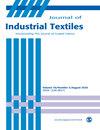Sound contour map of absorber panels from industrial spinning and weaving wastes
IF 2
4区 工程技术
Q1 MATERIALS SCIENCE, TEXTILES
引用次数: 0
Abstract
Recycled fibers obtained from pre-textile waste present advantages and challenges in acoustic absorber design. This study examines the potential of incorporating textile waste into acoustic absorption systems, with a focus on pre-used waste, to increase the percentage of recycled fibers in the textile industry using the quantitative method Used to evaluate the efficiency of panels manufactured in different sound frequencies, from up to 2000 Hz, and, in some cases, up to 3000 Hz Observations indicate that surface cleaning products, pneumafil waste a twist, comb bat residue and waste grinders exhibit the highest sound absorption coefficients in and using waste samples In addition, a procedure has been developed to evaluate the sound absorption reduction coefficient, which exposes high correlations with values obtained by other methods Sound contour mapping further confirms the homogeneity of the sample and reveals the effectiveness of specific sound absorption systems, such as air condition station filters, spinning pneumafil waste, and weaving waste (samples 18, 20, 21, and 23). Nevertheless, the study of integration emphasizes the ability to reuse waste fibers for sound insulation that can absorb adequate sound, reduce reflected sound, and offer a promising solution for dealing with noise pollution. A thorough examination of sound contour maps across absorber surfaces is undertaken to account for the material structure of the absorber, ensuring an accurate representation of how sound is absorbed and distributed within the designated area.利用工业纺纱和织布废料制作吸音板的声等值线图
从纺织废料中获得的再生纤维在吸声设计中既有优势也有挑战。本研究采用定量方法,探讨了将纺织废料纳入吸声系统的潜力,重点是使用前废料,以提高纺织业中再生纤维的比例。 观察结果表明,表面清洁产品、pneumafil 废料 a twist、此外,还开发了一个评估吸音降低系数的程序,该程序显示与其他方法获得的数值有很高的相关性 声音轮廓图进一步证实了样品的均匀性,并揭示了特定吸音系统的有效性,如空调站过滤器、纺纱气泡棉废料和织布废料(样品 18、20、21 和 23)。尽管如此,整合研究强调了重新利用废纤维进行隔音的能力,它可以吸收足够的声音,减少反射声,为解决噪声污染问题提供了一个前景广阔的解决方案。对吸收器表面的声音等高线图进行了彻底检查,以考虑吸收器的材料结构,确保准确反映指定区域内的声音吸收和分布情况。
本文章由计算机程序翻译,如有差异,请以英文原文为准。
求助全文
约1分钟内获得全文
求助全文
来源期刊

Journal of Industrial Textiles
MATERIALS SCIENCE, TEXTILES-
CiteScore
5.30
自引率
18.80%
发文量
165
审稿时长
2.3 months
期刊介绍:
The Journal of Industrial Textiles is the only peer reviewed journal devoted exclusively to technology, processing, methodology, modelling and applications in technical textiles, nonwovens, coated and laminated fabrics, textile composites and nanofibers.
 求助内容:
求助内容: 应助结果提醒方式:
应助结果提醒方式:


